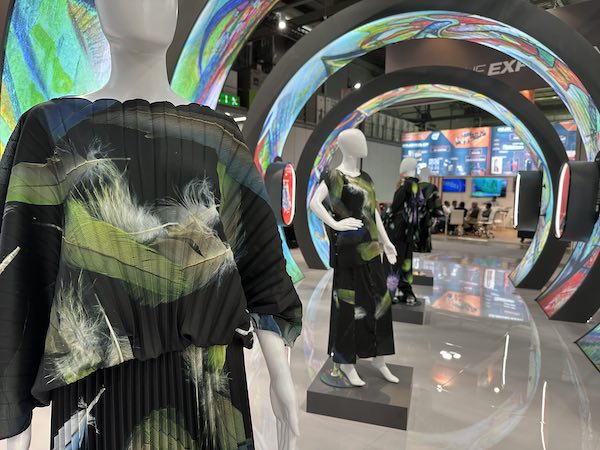
The Mimaki booth at ITMA 2023. (Image courtesy of Texintel.)
Post-pandemic, the textile industry has faced many challenges, commercial and environmental, but it is the latter where innovation and reform now reside—the commercial aspects will take care of themselves. Surely there can now be no doubt that digital technologies are the future of the industry. Digital technologies offer a viable solution for systemic reform, an impressive suite of innovations, and an essential bridge to sustainable manufacturing, on-demand and in-time. Looking at the number of machines sold during the exhibition (Kornit Digital 25 Prestos!) the facts seem to speak for themselves.
The future is now, and textile manufacturers across the globe are investing in digital technology for commercial success—success that is tied to environmentally conscious production and sustainable processes.
Hall 7 and Hall 5 were the focus for those interested in textile printing, and with so much technology to experience it was difficult (if not impossible) to find the time to venture anywhere else. Post-pandemic, this was the first opportunity for the industry to gather on what has become a global stage for textile innovation. Packed with cutting-edge technologies, automation and AI, the halls of ITMA were alive with a new energy, and an appetite for change.
Here are just a few of the key takeaways from the show, with more to follow. In the weeks ahead, we will come back to elaborate and revisit ITMA exhibitors and the countless innovations that made their debuts and take the time to dive deeper into the important technologies launched at the show; for now, the highlights.
Simplicity—Single-Step Production
Across the sector, there is a marked move towards delivering simplicity. New iterations of digital technologies were launched at the show, each focused on streamlining the process to simplify production, such as removing or automating the steps of printing textiles and scaling down ancillary processes to offer a smaller, more energy efficient footprint for printed production. Kornit Digital continued their success with the Presto; EFI Reggiani presented a new BOLT XS (single-pass) and new models of the Hyper which now function with pigment inks; and Epson launched a new vision for the ML8000 with inline pre- and post-finishing and a whole suite of innovations for the Monna Lisa series (printed resin, more on that later).
In summary: all exhibitors in hall 7 delivered one message: Keep it Simple.
Size vs. Speed—Small and Mighty
Single-pass technologies were presented as smaller, smarter iterations, looking nothing like the footprint of rotary but equalling the speed of screen. Small and mighty, single-pass has evolved along with printhead and ink technology to offer automated, high-speed (100mpm) AI-driven technology for efficient industrial production.
Inks Take on Hybrid Function
Digital inks across all processes have evolved, whether pigment, dye-sub, or reactive—ink is no longer just ink! Manufacturers now offer hybrid versions with pre-coating added or even post-coating (triggered by heat) all present in the ink formulation. Importantly, these inks are now available from independents like Sun Chemical, and thus serve to rationalize both process and ink prices.
DTF Makes a Move on DTG
The noise and excitement surrounding DTF (direct to film) continues with Mimaki launching their own DTF machine. As this agenda evolves, the print quality of DTF, as seen in the STS booth at the show, is improving. Hand feel varies across vendors, with vast improvements on the synthetic, rubberized hand of early machinery and inks. Controlling the white is key as is the quality and delivery of the powdered adhesive post print. With numerous benefits, DTF has a key role to play in garment decoration. Watch this space.
Automation Meets with AI
Circling back to where we started and the need to offer simplified production and process, automation and AI are driving the development of new iterations of existing machinery and new emerging technologies. This is all underpinned by the need for efficient, effective workflow automation—human hand and machine—as seen in the newly launched Apollo from Kornit Digital.
AI has a large role to play in color management, machine performance, and ultimately in controlling waste and energy efficiency. Data is the new gold; and when twinned with AI, it can deliver the transparency and traceability that the textile printing industry urgently needs to make sure that we monitor and quantify our environmental impact.
All in all, ITMA was an incredible show, packed with the technology and innovation required to re-equip the industry and to deliver more sustainable manufacturing and address key market shifts. More ITMA insights to follow in the weeks ahead…














